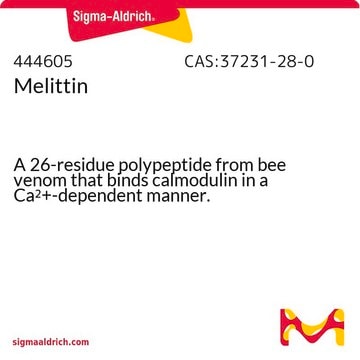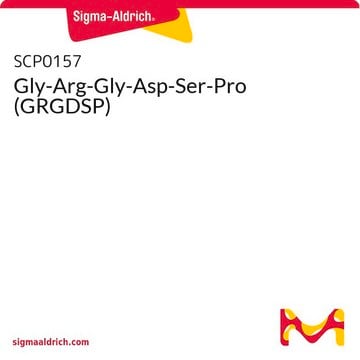N9039
nanoHA™7
low endotoxin
Iniciar sesiónpara Ver la Fijación de precios por contrato y de la organización
About This Item
Código UNSPSC:
12352201
Productos recomendados
Formulario
film
calidad
low endotoxin
impurezas
≤1 EU/mg endotoxin
temp. de almacenamiento
−20°C
Descripción general
The nanoHA products are small-molecular weight hyaluronic acid oligomers prepared by chemoenzymatic synthesis using immobilized enzymes. The name of each nanoHA indicates the number of monosaccharide units in the oligomer. The reducing end contains N-acetyl-D-glucosamine.
Aplicación
NanoHA has been used in a study to assess the nanomechanical properties of electrospun composite scaffolds. It has also been used in a study to investigate the influence of crystallite size of nanophased hydroxyapatite on fibronectin and osteonectin adsorption and on osteoblast adhesion and morphology.
Otras notas
nanoHA7 is a heptasaccharide containing three hyaluronan disaccharide subunits (GlcNAcβ4GlcAβ3GlcNAcβ4GlcAβ3GlcNAcβ4GlcAβ3GlcNAcβ4).
To gain a comprehensive understanding of our extensive range of Oligosaccharides for your research, we encourage you to visit our Carbohydrates Category page.
Forma física
Supplied lyophilized as the ammonium and/or sodium salt.
Nota de análisis
Sold on the basis of carbohydrate as determined by carbazole assay.
Información legal
nanoHA is a trademark of Hyalose LLC
Código de clase de almacenamiento
11 - Combustible Solids
Clase de riesgo para el agua (WGK)
WGK 3
Punto de inflamabilidad (°F)
Not applicable
Punto de inflamabilidad (°C)
Not applicable
Elija entre una de las versiones más recientes:
Certificados de análisis (COA)
Lot/Batch Number
¿No ve la versión correcta?
Si necesita una versión concreta, puede buscar un certificado específico por el número de lote.
¿Ya tiene este producto?
Encuentre la documentación para los productos que ha comprado recientemente en la Biblioteca de documentos.
Parul Tyagi et al.
Journal of nanoscience and nanotechnology, 9(8), 4839-4845 (2009-11-26)
Fibrous nanocomposite scaffolds were electrospun from dispersions of hydroxyapatite nanoparticles (nanoHA) in polycaprolactone (PCL) with varying nanoHA contents (from 0% to 50% by weight). Such scaffolds were produced to mimic the nano-features of the extracellular matrix (ECM) for natural bone
N Ribeiro et al.
Journal of colloid and interface science, 351(2), 398-406 (2010-09-03)
The characteristic topographical features (crystallite dimensions, surface morphology and roughness) of bioceramics may influence the adsorption of proteins relevant to bone regeneration. This work aims at analyzing the influence of two distinct nanophased hydroxyapatite (HA) ceramics, HA725 and HA1000 on
Staphylococcus aureus and Staphylococcus epidermidis adhesion to nanohydroxyapatite in the presence of model proteins
Ribeiro, M., et al.
Bio-medical materials and engineering, 7, 045010-045010 (2012)
Nuestro equipo de científicos tiene experiencia en todas las áreas de investigación: Ciencias de la vida, Ciencia de los materiales, Síntesis química, Cromatografía, Analítica y muchas otras.
Póngase en contacto con el Servicio técnico






